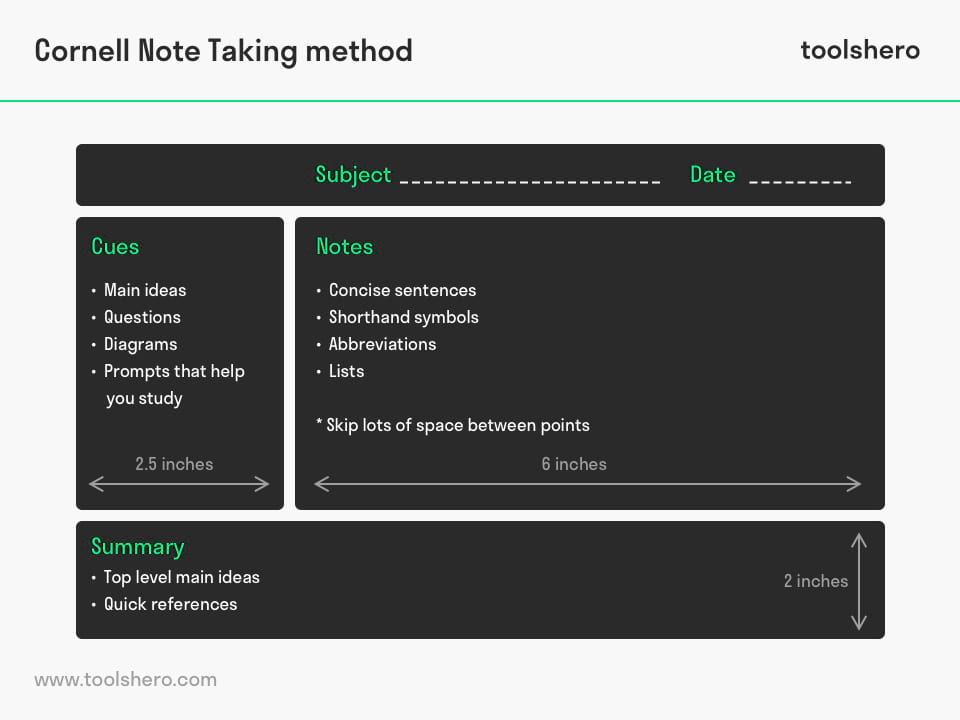Cornell Note Taking Method

This article explains the Cornell Note Taking method in a practical way. In addition to what it is, this article also explains the combination with Powerpoint and the benefits. After reading you will understand the basics of this handy note taking method. Enjoy reading!
Introduction
Do you need to write down notes about important information very quickly? If you do not know how to write shorthand, this seems to be an insurmountable task. However, the Cornell note taking method makes this possible.
Originally, the this method was a note-taking system that was used to take notes during lectures. The Cornell Note Taking method is named after the Cornell University and was developed by professor Walter Pauk. The method also works very well in other situations. This method is also known as Cornell Note Taking system or Cornell notes.
Cornell Note Taking method template
The strength of this method is the simple page layout. At the top of the page you write down the name of the course, meeting or seminar together with the date and the subject.
Then the page is divided into three parts; a column on the right for taking brief notes and the left column for any questions relating to the notes and near the bottom of the page there is space for brief summaries.

Figure 1 – Cornell Note Taking Method Example
Abbreviations and the cornell note taking method
This method discourages the use of long sentences. It is about short notes that you write down in the right-hand column using recognizable abbreviations and symbols.
Prior to the note taking a list of abbreviations and expressions can be drawn up, which makes the note-taking even easier. Important concepts, ideas, persons, formulas and graphs are also written down in the right-hand column.
Brief but to the point
The questions are written down on the left-hand side of the paper using keywords about the important aspects of the lecture or seminar. Numbers may refer to the notes on the right. At the bottom of the page you write a brief summary in your own words.
This can be done during the lecture or seminar or immediately after. In case of complex information, it is advisable to fully work out the notes immediately after the lecture or seminar has finished.
Powerpoint
This method can also be used in combination with a Powerpoint presentation. If you have a printed version, then notes can be created in the right-hand margin and short questions can be formulated in the left-hand margin. A summary is generally displayed on the last page but can be supplemented with your own notes. If you use a laptop, notes can be made at the bottom of the pages.
Cornell note taking method advantages
Apart from the fact that notes can be taken quickly with this method, it has another advantage. It takes a short time to absorb information as a result of which effective learning is stimulated.
Because of the good overall picture, the lecture material can be studied again so that you can arrive at the core of the subject matter and apply the lecture material more quickly.
It’s Your Turn
What do you think? Is this method applicable in today’s modern learning world? Do you recognize the practical explanation or do you have more suggestions? What are your success factors?
Share your experience and knowledge in the comments box below.
More information
- Herr, Norman (2008). The Sourcebook for Teaching Science, Grades 6-12: Strategies, Activities, and Instructional Resources. John Wiley & Sons, p. 47.
- Kruse, Darryn (2010). Thinking Tools for the Inquiry Classroom. Curriculum Press, p. 32.
- Pauk, W. O. & Ross J. Q. (1962). How to Study in College. Cengage Learning.
- Wong, Linda (2014). Essential Study Skills. Cengage Learning.
How to cite this article:
Mulder, P. (2012). Cornell Note Taking method. Retrieved [insert date] from Toolshero: https://www.toolshero.com/personal-development/cornell-note-taking-method/
Oorspronkelijke publicatiedatum: 10/21/2012 | Last update: 07/03/2023
Add a link to this page on your website:
<a href=”https://www.toolshero.com/personal-development/cornell-note-taking-method/”>Toolshero: Cornell Note Taking method/</a>












